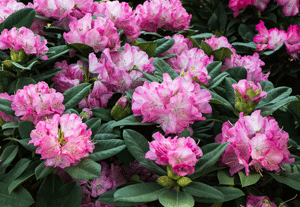Rhododendrons: Spring Planting and Care Tips
 Rhododendrons are never more noticeable than spring, when they cover themselves with blooms. It’s enough to inspire you to plant more rhodies in your garden. Here are tips for siting and planting these shade-tolerant favorites, plus spring care tips for those already in the garden.
Rhododendrons are never more noticeable than spring, when they cover themselves with blooms. It’s enough to inspire you to plant more rhodies in your garden. Here are tips for siting and planting these shade-tolerant favorites, plus spring care tips for those already in the garden.
Where to plant rhododendrons:
- Rhododendrons are shrubs of woodland edges, and they prefer a similar setting in the garden. They do best with part sun (preferably morning sun). They will grow in full shade if it is cast by trees whose limbs are 20 to 30 feet above the ground.
- Avoid siting rhododendrons where they’ll be exposed to harsh winter winds.
The site should have good drainage and no competition from trees with roots near the surface, such as maples. - The best soil will be acidic and rich with organic matter.
- Be sure to choose a variety whose mature size will not be bigger than the space you’ve allowed. Height is particularly key; do not choose a rhododendron that will grow to obscure window or sight lines, as they do not look good pruned back. Width may be less of a concern, as you may be able to remove neighboring plants if the rhododendron begins to encroach on them. (If you are planting the rhodie alongside favorite plants or in a space with unmovable objects, do pay heed to the mature width.)
How to plant rhododendrons:
- In cold regions, plant rhododendrons in early spring. Fall is the second choice.
- In warmer regions, the first choice for planting time is fall, just before the rainy season.
- Dig a wide, shallow hole. The depth should be just so that when you place the root ball inside of the hole, its top will be at the same level as it was in its container mix. (In other words, do not plant a rhododendron deep and mound soil over its crown.)
- Gently rough up the sides of the root ball so that roots hang free from it.
- Bury the root ball firmly but gently, and avoid packing soil the down hard.
- Water deeply and apply up to 3 inches of mulch. Do not press the mulch right up against the rhododendron’s crown and stems; leave some space bare.
- Keep newly planted rhododendrons watered, especially during dry spells. Water deeply but allow the soil to approach dryness before watering again. Be sure to keep rhododendrons, especially new ones (planted spring or fall) watered throughout the fall, right up until the ground freezes (or, in warmer areas, until winter rains begin).
Caring for rhododendrons in spring:
- Remove any branches killed or damaged by winter weather, pruning them back to live/healthy wood.
- Question: Winter did a number on my rhododendrons, which I did not wrap. There are brown, curled leaves and some stem ends appear dead. Should I cut these all off, or what else can I do to improve the shrubs’ look? Answer: Exposure to harsh sun and wind in winter can cause dry, brown, curled leaves and/or branches. Patience is key as you wait for the plant to bounce back, which it very well may do. In the meantime, you can remove dead leaves to make way for new ones. After you’ve given the plant plenty of time to begin spring growth—waiting until late spring—you can then scratch the bark on dead-looking branches with your fingernail. If there is green wood underneath, the branch is still alive. Leave it in place because it may push out new growth yet. If it’s brown underneath, the branch is dead and you can prune it off. In spring, treat winter-damaged rhododendrons and azaleas with a fertilizer formulated for them, such as Holly-Tone. Follow the package directions—don’t give them more than it indicates, because doing so could cause further injury or death. Keep the plants watered if rain is scarce.
- Rhododendrons do not usually need fertilizing if they are growing well. If the plant seems to be lagging, a feed for acid-loving plants can be applied in early spring.
- Apply additional mulch if existing mulch is less than 2 or 3 inches; add just enough to bring it up to that total depth.
- Remove spent flowers by pinching them off with your fingers.